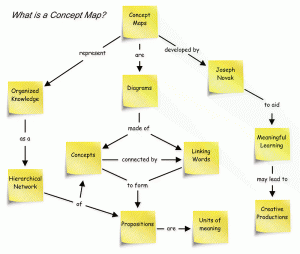What is it?
A concept map is a graphic tool which helps students to visually represent a concept. Concept maps can be used as an in-class or online activity to stimulate discussion; as formative assessment to show how well students have understood a topic; or as a diagnostic assessment to assess their prior learning (Ambrose et al, 2010). Concept maps represent some of the physical structures that take place in our brains when we learn new knowledge. They have been used as summative assessment in science and medicine to assess students’ developing framework of key concepts. They have also been used in humanities and disciplines where visual depictions of knowledge is valued equally to written representations.

Image taken from https://www.cooper.com/journal/2016/8/concept-mapping-for-designers-of-the-future
Why would I use it?
- It can help distinguish whether students have rote-learned, partially understood or really internalised a concept/idea/topic/theory. If students draw their concept map and then explain it to others, it is easier to assess the normally internalised processes of learning because learning itself is externally represented. It provides “a window into students’ minds” (Shavelson et al, 2005:416).
- It provides an instantaneous feedback loop, as the teacher can assess whether students have really understood the ideas in the lecture or the concept being studied, and can guide and adjust the students’ misunderstandings before they go on to complete more complex assignments.
- It facilitates higher level thinking skills such as making connections, application, criticality and application of ideas. It also emphasises creative thinking in the way students’ represent structures and relationships between ideas.
- Digital technology can support concept mapping; therefore it is particularly useful for blended or fully online courses as a means of active learning. Software tools such as CMAP also allow for concept mapping to be used as assessment.
Known issues:
- It is not easy to assess formally. Although some researchers have developed grading frameworks for summative assessment, in medical education for example, its reliability is debatable (West et al, 2002; Ruiz-Primo, 2004) It requires experts in the field to mark the concepts and a complex scoring rubric and marker training to use this.
Therefore, it probably works better formatively as it encourages students to take risks in representing their understanding.
How has it been used?
While in class activities work best when students construct their own maps (Yin et al 2001), there are three different approaches for using concept maps in assessment.
a) a structured approach requires users to construct concept maps in a pre-specified format such as a flow diagram or a cyclical cycle. This is the most common. Concepts are enclosed in circles or boxes, labelled with arrows to show relationships between concepts. The relationships are shown though linking phrases such as e.g., “gives rise to”, “results in”, “is required by,” or “contributes to”.
b) a semi-structured approach where the concept maps are partially filled in and students have to complete or they have to manipulate the elements by evaluating the correctness or comparing the best representation from a series of maps.
c) an unstructured approach which gives students freedom to choose their own format.
Dr. Karen Rohrbauck Stout describes her use of concept mapping in a Media and Communications department in this short video
Kandiko et al (2013) discuss the application of concept mapping as a reflective tool in Classics.
UC Dublin provide a workbook for using concept maps as assessment
Vanderbilt University provides some examples: https://cft.vanderbilt.edu/guides-sub-pages/beyond-the-essay/beyond-the-essay-formative/#conceptmaps
- Concept maps need time to prepare as they are different from mind mapping/brainstorming. If you are using this as part of an exam for example, factor in the time required.
- Concept maps can be used for individuals or for small groups, or for the whole class, depending on the class sizes.
